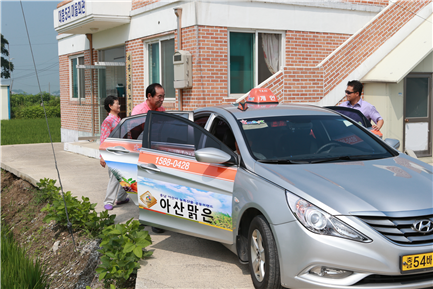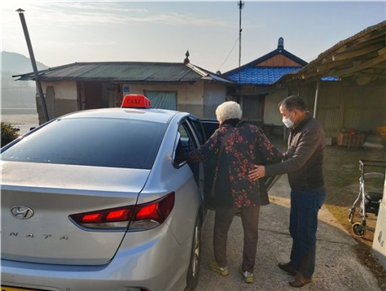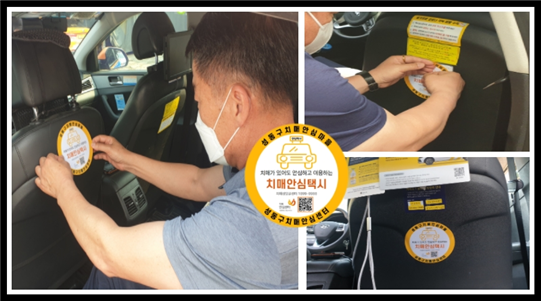※ Introducing Korea’s Best Practice of Local Governments for Older Persons. This is a monthly report that aims to introduce examples of outstanding policies and practices adopted by local and municipal governments in Korea to help older persons exercise their human rights. These examples are selected with reference to the report ‘Human Rights to be Included in the New UN Convention on the Rights of Older People’, published by the National Human Rights Commission of Korea in 2018. While various attempts have been made by local and municipal governments in Korea to improve the well-being of older persons, they are not very well known outside the country. ASEM Global Ageing Center (AGAC) aims to fill this gap by introducing in depth the best practices local governments have implemented in the interests of older persons.
This report introduces taxi services in Asan-si's 'Pick-up Taxi'; Hongseong-gun's 'A program for accompanying to hospital older persons who live alone'; and Seoul's 'Dementia-Friendly Taxi Service'.
Promoting the Mobility Rights of Older Persons by Employing Taxi Services
With the population ageing, increasing attention is being paid to the mobility rights of older persons. Many older persons live healthier lives and have more cars than previous generations, so they enjoy better mobility rights. However, the government still classifies a significant portion of the older population as “mobility handicapped”. Therefore, both central and local governments are making efforts to secure better mobility rights for older persons.
*Mobility handicapped refers to a person experiencing hardship in using daily transportation, including the disabled, older persons, pregnant women, and persons accompanying infants.
To alleviate the high cost of taxi services for many older people, and actively utilize their mobility and convenience, central and local governments are providing financial assistance so the mobility handicapped can use taxis and simultaneously the income of taxi drivers can be secured. According to the National Private Taxi Transportation Business Association, as of December 31, 2021, there were approximately 250,000 taxi vehicles in Korea. In Seoul 2018, the average monthly income of taxi drivers registered with companies was 2,170,000 KRW. In its analysis of the 2020 income of waged labor, Statistics Korea indicated the average monthly income of Korean workers in December 2020 was 3,200,000 KRW, which suggests taxi drivers earn 1,000,000 KRW less than the average worker in Korea. This report note introduces several examples of programs run by central and local governments to achieve the twin goals of securing the income of taxi drivers and meeting the transport needs of older users, promoting their mobility rights. It also describes a program which utilizes taxi services to protect older persons with dementia.
1. Asan-si, ‘Pick-up Taxi’(100 KRW Taxi)
In November 2012, Asan-si, Chungcheongnam-do, introduced what it calls a Pick-up Taxi, the first in Korea. The program was developed in light of the fact that population ageing has reduced demand for public transportation. This has led to several bus routes being discontinued and business operations downsized, as a result of which many areas are without access to public transport. Local government intended to boost the local economy by ensuring transportation assistance and mobility rights for persons living in remote areas.
The 100 KRW taxi ride is a government-funded service that provides transportation to areas not served by public bus routes. Although the fare could actually cost much more than 100 KRW, given the distances sometimes involved, for users this is generally a highly affordable taxi service, since they pay only 100 KRW and local government pays the rest. Asan-si enacted an “Ordinance for Promoting the Transportation Welfare of citizens living in a remote area”,” and thereby established what had been the pilot program for the Pick-up Taxi as a regular official program.
The program aims to provide a service to citizens living in or visiting areas that lacking public bus routes. The service is available within thirty minutes of the user requesting a ride. The fare is 100 KRW within 3km from the point of departure to the bus stop. Exceeding the 3km limit is allowable up to a maximum of 1,600 KRW, which is paid by the local government. Currently, Asan-si provides the service to 107 local villages such as Dogo, Seonjang, and Songak. Business hours are from 7 AM to 9 PM, and drivers ply between the villages four to eight times a day. The average daily number of Pick-up Taxi users in Asan-si is about 270 persons.
The Pick-up Taxi is popular among locals for providing much-needed transportation in remote areas while reducing the financial costs of using a taxi. It also benefits the bus companies by not operating routes yielding low revenues. Therefore, both service provider and consumer can benefit. Songak-myeon, Asan-si, reduced bus service vehicles from six to four, and employed more Pick-up Taxis, thus saving money while promoting the convenience of local users. Now Jangsu-gun(Jeollabuk-do), Cheongju-si(Chungcheongbuk-do), and Pohang-si(Gyeongsangbuk-do) provide similar taxi services, following the example of Asan-si.
A user commented, “It was challenging to visit downtown since the bus stop was far from the village. Now, we can easily get to the bus stop by riding a taxi”. Drivers are also responding positively to the program, since they can both help local residents and get customers outside the usual rush hours.

‘Pick-up Taxi’, Asan-si(from Asan-si)
2. Gyeolseong-myeon, Hongseong-gun: A program for accompanying to hospital older persons who live alone
Gyeolseong-myeon, Hongseong-gun, has a population of 2,057, and among them are 1,051 persons above the age of 65–51 per cent of the total population. Gyeolseong-myeon initiated a program for accompanying to hospital older persons who live alone, to ensure their mobility rights, which are threatened by extreme ageing and the absence of public transportation. The program aims to help older persons living alone who have difficulty attending hospital because of personal mobility problems or lack of transportation.
The service dispatches two people, a taxi driver and a volunteer, to accompany an older person from their residence to the hospital. The program not only provides mobility support, but also helps older persons with registration and payment in hospitals and pharmacies. Every user can enjoy the service twice a month, 24 times a year, for a fee of 1,000 KRW per call(the local government pays the taxi fare). The program started as a pilot in October 2021. It expanded significantly during 2022; the county estimated the user pool increased from 39 users in 2021 to about 90 users in 2022(39 existing users, plus 52 other older persons living alone in remote areas). Taxi drivers earn 40,000 KRW per fare, and accompanying volunteers are paid 20,000 KRW per fare, both from the local government budget.
One user commented, “My son had to come over and take me to the hospital for regular medical treatment. I recently had to visit a dermatologist, but my son couldn’t come every time. The fact that the consultative group(consultative group for Local Social Security) is providing an accompanying service helped immensely. Since I can’t move freely without the help of others, without the service I would have been severely ill. Thank you for the service.”

Accompanying to hospital for older persons living alone (Source: Gyeolseong-myeon Administrative Welfare Center)
3. Seongdong-gu, Seoul: Dementia-Friendly Taxi Service
Seongdong-gu, Seoul, is providing a Dementia-Friendly Taxi Service, an outstanding case of community care in Korea. The National Institution of Dementia reports there were approximately 886,000 people with dementia in 2021, 10.33 per cent of the total older population. Of this number, 147,000(16.6 per cent of the total) live in Seoul. This means 9.58 per cent of older persons living in Seoul have dementia. This is slightly lower than the national average, but Seoul has the most persons living with dementia after Gyeonggi-do. 9.58 per cent is narrowly lower when comparing the ratio of the older population living in Seoul(1.6 million) to the total older population of Korea(8.9 million); Seoul is home to about 18.0 per cent of the country's older population(Statistics Korea, 2021).
Local governments, including Seoul, provide community care programs to support ageing in place instead of in institutions. This is to ensure the well-being of older persons. Seongdong-gu designated Geumho-dong(2019), Seongsu-dong(2020), Gaje-dong(2020), and Majang-dong(2022) as Dementia-Friendly Towns, building appropriate infrastructure. A Dementia-Friendly Town intends to support patients and their families to engage actively with local stores, transportation services, local businesses, and other relevant institutions. Every store displays a sticker informing people that they are Dementia-Friendly.
As part of the program, Seongdong-gu provides a taxi service to manage potential problems for people with dementia when they go out. Drivers understand the characteristics of the illness and provide a safe travel service for people with dementia, in order to bring positive change to the local community(Dementia Safe Center of Seongdong-gu, 2022). The Dementia Safe Center of Seongdong-gu made a business agreement with five local taxi companies, then distributed 300 stickers and 300 car air fresheners with the Dementia-Friendly Taxi logo. By these means, local government can advertise the concept of a Dementia-Friendly Town, and the Dementia Safe Center, and raise awareness.
Taxi drivers attend an education program in the Dementia Safe Center of Seongdong-gu to learn relevant knowledge. The service does not provide financial support for the fare. However, it makes use of the fact that taxis move around the various areas. A taxi driver can discover older persons with dementia wandering around the streets contacts the Dementia Safe Center, and rescue them before an emergency. Taxi services for older persons are expanding nationwide. Sunchang-gun, Jeollabuk-do also provides taxi services for older persons with dementia. It delivers mobility services for older persons with mild dementia, taking them from their homes to the Dementia Safe Center, free of charge.
